
|
Now it is 9.5 mag (Jan. 23, Maik Meyer). It brightens up to 8 mag in spring, and it is observable in good condition in the Northern Hemisphere. In the Southern Hemisphere, it is not observable until July.
Date(TT) R.A. (2000) Decl. Delta r Elong. m1 Best Time(A, h)
Jan. 25 2 26.09 57 30.8 1.595 2.094 106 9.1 18:48 (167, 66)
Feb. 1 2 16.19 57 58.7 1.627 2.038 99 9.0 18:54 (156, 63)
|

|
Now it is 12.5 mag (Jan. 21, Maik Meyer). It stays bright as 12-13 mag until summer. But it becomes low in spring. In the Southern Hemisphere, it will never be observable again.
Date(TT) R.A. (2000) Decl. Delta r Elong. m1 Best Time(A, h)
Jan. 25 23 33.60 41 30.9 3.326 3.208 74 12.2 18:48 (116, 49)
Feb. 1 23 36.80 42 18.5 3.419 3.224 70 12.2 18:54 (118, 43)
|

|
Bright new comet. Now it is 12.4 mag and visible visually (Jan. 14, Alan Hale). It approaches to Sun down to 0.84 a.u. in March, then it brightens up to 11 mag. In the Northern Hemisphere, it stays observable for a long time, although it becomes extremely low in March. In the Southern Hemisphere, it is observable only until late January. It seems to be a fragment of C/1988 A1 (Liller), like C/1996 Q1 (Tabur) and C/2015 F3 (SWAN).
Date(TT) R.A. (2000) Decl. Delta r Elong. m1 Best Time(A, h)
Jan. 25 23 41.85 -11 8.3 1.657 1.234 47 13.0 18:48 ( 56, 24)
Feb. 1 23 44.19 -5 45.0 1.654 1.149 42 12.7 18:54 ( 66, 22)
|

|
Bright new comet. Now it is 12.5 mag (Jan. 20, Shigeki Murakami). It stays 13 mag until February. In the Northern Hemisphere, it stays observable in good condition after this. It is not observable in the Southern Hemisphere.
Date(TT) R.A. (2000) Decl. Delta r Elong. m1 Best Time(A, h)
Jan. 25 18 8.57 19 41.4 1.286 1.022 51 13.1 5:36 (267, 32)
Feb. 1 18 19.19 28 14.6 1.147 1.062 59 13.1 5:32 (260, 38)
|

|
Now it is 15.2 mag (Jan. 20, Toshihiko Ikemura, Hirohisa Sato). It will be unobservable soon in the Southern Hemisphere.
Date(TT) R.A. (2000) Decl. Delta r Elong. m1 Best Time(A, h)
Jan. 25 0 38.32 13 21.1 6.047 5.787 70 13.6 18:48 ( 66, 51)
Feb. 1 0 41.98 13 36.4 6.151 5.787 63 13.7 18:54 ( 73, 45)
|
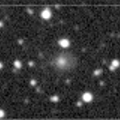
|
Now it is bright as 13.8 mag (Dec. 28, Chris Wyatt). It stays 14 mag until spring. It stays observable for a long time in the Southern Hemisphere. It is not observable until August in the Northern Hemisphere.
Date(TT) R.A. (2000) Decl. Delta r Elong. m1 Best Time(A, h)
Jan. 25 0 25.67 -72 52.1 3.808 3.473 63 14.1 18:48 ( 12,-21)
Feb. 1 0 40.52 -69 55.0 3.827 3.483 62 14.1 18:54 ( 15,-19)
|

|
In the Southern Hemisphere, it is observable at 14.5 mag from winter to spring. In the Northern Hemisphere, it is not observable until August when it fades down to 17 mag.
Date(TT) R.A. (2000) Decl. Delta r Elong. m1 Best Time(A, h)
Jan. 25 21 26.07 -74 16.3 2.411 2.026 55 14.5 18:48 ( 19,-32)
Feb. 1 22 41.98 -73 12.2 2.362 2.018 57 14.4 18:54 ( 19,-29)
|

|
Now it is 14.1 mag (Jan. 12, Sandor Szabo). In the Northern Hemisphere, it is observable at 14 mag in excellent condition in winter. It locates low in the Southern Hemisphere.
Date(TT) R.A. (2000) Decl. Delta r Elong. m1 Best Time(A, h)
Jan. 25 3 30.93 19 16.9 0.937 1.583 110 14.9 19:16 ( 0, 74)
Feb. 1 3 46.35 17 54.9 0.992 1.590 107 15.0 19:04 ( 0, 73)
|
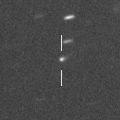
|
Now it is 16.0 mag (Jan. 1, Toshihiko Ikemura, Hirohisa Sato). It will brighten up to 13.5-14 mag from 2020 to 2021. It stays observable in good condition for a long time after this until 2020 summer.
Date(TT) R.A. (2000) Decl. Delta r Elong. m1 Best Time(A, h)
Jan. 25 13 13.78 12 8.4 3.019 3.493 110 15.3 5:00 ( 0, 67)
Feb. 1 13 15.86 12 30.4 2.914 3.475 117 15.2 4:34 ( 0, 67)
|
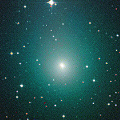
|
It brightened up to 8.3 mag in September (Sept. 20, Maik Meyer). Now it is fading. It has already faded down to 14.9 mag (Dec. 28, Chris Wyatt). In the Southern Hemisphere, it stays observable for a long time after this. In the Northern Hemisphere, it will never be observable again.
Date(TT) R.A. (2000) Decl. Delta r Elong. m1 Best Time(A, h)
Jan. 25 22 28.46 -47 24.5 3.102 2.399 37 15.2 18:48 ( 40,-13)
Feb. 1 22 37.28 -47 48.6 3.184 2.468 36 15.4 18:54 ( 43,-16)
|
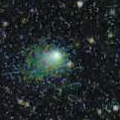
|
Now it is 15.1 mag (Dec. 27, Toshihiko Ikemura, Hirohisa Sato). Fading slowly. It is already unobservable in the Southern Hemisphre. It will be unobservable in early March also in the Northern Hemisphere.
Date(TT) R.A. (2000) Decl. Delta r Elong. m1 Best Time(A, h)
Jan. 25 23 12.06 -6 54.4 2.571 1.956 42 15.3 18:48 ( 65, 22)
Feb. 1 23 28.84 -5 34.4 2.645 1.985 39 15.5 18:54 ( 69, 19)
|

|
Now it is 14.6 mag (Dec. 28, Chris Wyatt). It will be fading slowly after this. In the Southern Hemisphere, it becomes low from February to March, but it stays observable for a long time. In the Northern Hemisphere, it is not observasble until summer in 2020.
Date(TT) R.A. (2000) Decl. Delta r Elong. m1 Best Time(A, h)
Jan. 25 22 37.74 -51 30.0 4.142 3.464 41 15.4 18:48 ( 36,-14)
Feb. 1 22 45.86 -49 28.1 4.203 3.494 39 15.5 18:54 ( 40,-16)
|
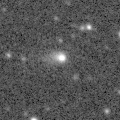
|
Now it is 14.9 mag (Jan. 20, Toshihiko Ikemura, Hirohisa Sato). It will fade out rapidly after this, and it will be fainter than 18 mag in late March. In the Southern Hemisphere, it is already unobservable.
Date(TT) R.A. (2000) Decl. Delta r Elong. m1 Best Time(A, h)
Jan. 25 23 8.59 2 41.7 2.407 1.855 45 15.4 18:48 ( 73, 27)
Feb. 1 23 24.42 4 48.8 2.469 1.874 43 15.7 18:54 ( 78, 25)
|

|
It brightened up to 7.7 mag in June in 2018 (June 19, Juan Jose Gonzalez). Now it is fading. It has already faded down to 14.7 mag (Dec. 31, Toshihiko Ikemura, Hirohisa Sato). In the Southern Hemisphere, it stays observable for a long time until the comet will fade out. In the Northern Hemisphere, it stays low for a while.
Date(TT) R.A. (2000) Decl. Delta r Elong. m1 Best Time(A, h)
Jan. 25 5 43.84 -29 12.5 5.290 5.814 117 15.5 21:27 ( 0, 26)
Feb. 1 5 39.77 -28 1.3 5.392 5.870 114 15.5 20:55 ( 0, 27)
|
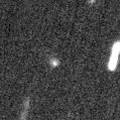
|
Now it is 15.6 mag (Jan. 4, Toshihiko Ikemura, Hirohisa Sato). It will brighten up to 10.5 mag from 2020 December to 2021 January. In the Northern Hemisphere, it stays observable in good condition while the comet will be brightening gradually, but it is not observable at the high light. In the Southern Hemisphere, it is not observable for a long time, but it will be observable in good condition after the high light.
Date(TT) R.A. (2000) Decl. Delta r Elong. m1 Best Time(A, h)
Jan. 25 18 14.49 61 10.9 4.010 4.038 84 15.6 5:36 (216, 42)
Feb. 1 18 21.33 61 48.7 3.939 3.974 84 15.5 5:32 (215, 44)
|
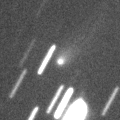
|
Now it is 15.3 mag (Jan. 4, Thomas Lehmann). The orbit is extremely hyperbolic with e=3.35. It is the first interstellar comet in history. It stays 15 mag until January. In the Northern Hemisphere, it will be unobservable in mid January. In the Southern Hemisphere, it is observable in excellent condition.
Date(TT) R.A. (2000) Decl. Delta r Elong. m1 Best Time(A, h)
Jan. 25 12 37.59 -51 27.0 2.030 2.266 90 15.6 4:24 ( 0, 4)
Feb. 1 12 44.78 -55 5.5 2.076 2.341 92 15.8 4:03 ( 0, 0)
|
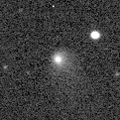
|
Now it is 14.8 mag (Dec. 28, Chris Wyatt). Fading slowly. It will be unobservable soon. It will appear in the morning sky in April in the Southern Hemisphere, or in June in the Northern Hemisphere.
Date(TT) R.A. (2000) Decl. Delta r Elong. m1 Best Time(A, h)
Jan. 25 23 18.14 -20 27.2 5.665 4.956 40 15.6 18:48 ( 53, 13)
Feb. 1 23 22.66 -19 13.9 5.766 4.991 35 15.7 18:54 ( 59, 9)
|

|
Now it is 16.3 mag (Jan. 19, Toshihiko Ikemura, Hirohisa Sato). It will be fading gradually after this. It will be fainter than 18 mag in April.
Date(TT) R.A. (2000) Decl. Delta r Elong. m1 Best Time(A, h)
Jan. 25 9 21.43 6 8.7 2.044 2.993 161 15.8 1:08 ( 0, 61)
Feb. 1 9 15.75 6 36.3 2.054 3.025 168 16.0 0:35 ( 0, 61)
|
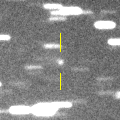
|
First return of a new periodic comet discovered in 2006. Now it is 15.8 mag (Nov. 29, Toshihiko Ikemura, Hirohisa Sato). It will brighten up to 15.5 mag in spring. But it is not observable around that time.
Date(TT) R.A. (2000) Decl. Delta r Elong. m1 Best Time(A, h)
Jan. 25 22 35.48 -13 43.3 2.578 1.813 31 15.9 18:48 ( 65, 10)
Feb. 1 22 53.60 -12 38.7 2.585 1.788 28 15.8 18:54 ( 69, 8)
|
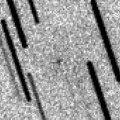
|
Now it is 16.7 mag (Jan. 21, Toshihiko Ikemura, Hirohisa Sato). It became much brighter than in early January. Now it is passing only 0.1 a.u. from Earth. Michael Jager reported it has a faint coma with a diameter of 50-60 arcsec. It is obesrvable in excellent condition in the Northern Hemisphere. In the Southern Hemisphere, it is not observable until mid February.
Date(TT) R.A. (2000) Decl. Delta r Elong. m1 Best Time(A, h)
Jan. 25 7 50.95 64 17.8 0.133 1.082 134 15.9 23:43 (180, 62)
Feb. 1 8 51.56 54 36.4 0.175 1.130 142 16.3 0:09 (180, 70)
|
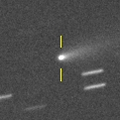
|
Now it is 15.6 mag (Dec. 27, Toshihiko Ikemura, Hirohisa Sato). It will fade out rapidly after this, and it will be fainter than 18 mag in March.
Date(TT) R.A. (2000) Decl. Delta r Elong. m1 Best Time(A, h)
Jan. 25 11 29.80 12 35.6 1.131 1.958 135 15.9 3:16 ( 0, 67)
Feb. 1 11 30.73 13 11.5 1.116 1.989 142 16.2 2:50 ( 0, 68)
|

|
Now it is 15.3 mag (Jan. 5, Toshihiko Ikemura, Hirohisa Sato). It is expected to be observable at 5-6 mag for a long time from 2022 to 2023. In the Northern Hemisphere, it is not observable at the high light from 2022 summer to 2023 summer. In the Southern Hemisphere, it stays unobservable for a while. But it will be observable in good condition at the high light.
Date(TT) R.A. (2000) Decl. Delta r Elong. m1 Best Time(A, h)
Jan. 25 18 1.88 45 43.1 10.202 9.953 72 16.0 5:36 (237, 42)
Feb. 1 18 5.13 45 57.2 10.130 9.904 74 16.0 5:32 (237, 46)
|

|
It will be fading slowly after this. In the Southern Hemisphere, it stays observable in good condition for a long time. It will never be observable after this in the Northern Hemisphere.
Date(TT) R.A. (2000) Decl. Delta r Elong. m1 Best Time(A, h)
Jan. 25 14 26.78 -67 40.8 4.924 4.718 72 16.2 5:36 (356,-13)
Feb. 1 14 20.42 -69 23.0 4.890 4.762 76 16.2 5:32 (359,-14)
|
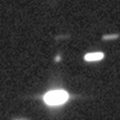
|
Now it is 16.9 mag (Jan. 2, Kunihiro Shima). It will brighten up to 13 mag in 2021. In 2020, it is observable at 15 mag in good condition from spring to summer.
Date(TT) R.A. (2000) Decl. Delta r Elong. m1 Best Time(A, h)
Jan. 25 14 58.37 -13 41.5 5.843 5.721 78 16.4 5:36 (338, 39)
Feb. 1 15 0.23 -14 14.5 5.685 5.677 84 16.3 5:32 (345, 39)
|
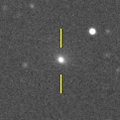
|
Now it is 15.5 mag (Jan. 20, Toshihiko Ikemura, Hirohisa Sato). It will be fading slowly after this.
Date(TT) R.A. (2000) Decl. Delta r Elong. m1 Best Time(A, h)
Jan. 25 1 2.04 1 32.9 2.480 2.347 70 16.4 18:48 ( 47, 46)
Feb. 1 1 13.23 2 54.0 2.558 2.351 66 16.5 18:54 ( 54, 44)
|

|
Now it is 17.5 mag (Dec. 28, Toshihiko Ikemura, Hirohisa Sato). It stays 16-17 mag for a long time until 2020. It is observable in good condition in the Northern Hemisphere. In the Southern Hemisphere, it is observable in the extremely low sky only in 2021 spring.
Date(TT) R.A. (2000) Decl. Delta r Elong. m1 Best Time(A, h)
Jan. 25 13 30.87 53 55.2 8.231 8.670 113 16.8 5:17 (180, 71)
Feb. 1 13 30.54 54 19.3 8.198 8.680 116 16.8 4:49 (180, 71)
|
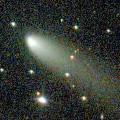
|
It brightened up to 11.4 mag in autumn (Nov. 10, Carlos Labordena). Now it is fading. It has already faded down to 14.8 mag (Dec. 28, Chris Wyatt). It is observable in excellent condition in the Northern Hemisphere. It stays locating extremely low in the Southern Hemisphere.
Date(TT) R.A. (2000) Decl. Delta r Elong. m1 Best Time(A, h)
Jan. 25 3 23.30 40 48.6 1.428 2.027 113 16.9 19:08 (180, 84)
Feb. 1 3 35.36 40 8.9 1.538 2.075 108 17.3 18:54 (177, 85)
|

|
Fading. It is observable at 17 mag in good condition in spring. But it will be fainter than 18 mag in June.
Date(TT) R.A. (2000) Decl. Delta r Elong. m1 Best Time(A, h)
Jan. 25 16 50.86 -8 21.1 3.134 2.663 53 16.9 5:36 (306, 29)
Feb. 1 17 2.08 -8 1.5 3.103 2.702 57 17.0 5:32 (309, 31)
|
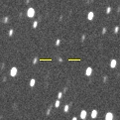
|
Now it is 16.7 mag (Dec. 3, D. Buczynski). It will stay at 14 mag for a long time from 2021 to 2022. In the Northern Hemisphere, it stays observable in good condition while brightening gradually, although it becomes low in December and January. In the Southern Hemisphere, it is not observable until March.
Date(TT) R.A. (2000) Decl. Delta r Elong. m1 Best Time(A, h)
Jan. 25 18 59.44 29 40.8 7.490 6.944 53 17.0 5:36 (251, 26)
Feb. 1 19 2.47 29 38.4 7.439 6.910 54 16.9 5:32 (253, 30)
|
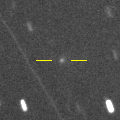
|
Now it is 18.1 mag (Jan. 5, Toshihiko Ikemura, Hirohisa Sato). It moves along the same orbit as C/1844 Y1 (Great Comet). It approaches to Sun down to 0.25 a.u. on May 30. It is expected to brighten up to 6 mag. In the Northern Hemisphere, it stays observable in excellent condition until mid May when it brightens up to 9 mag. In the Southern Hemisphere, it is observable only until mid February.
Date(TT) R.A. (2000) Decl. Delta r Elong. m1 Best Time(A, h)
Jan. 25 11 51.87 39 10.8 1.785 2.547 131 17.3 3:38 (180, 86)
Feb. 1 11 49.94 42 17.5 1.645 2.446 135 17.0 3:09 (180, 83)
|
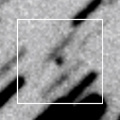
|
Asteroid moving along a comet-like orbit. Now it is 16.5 mag (Dec. 27, Toshihiko Ikemura, Hirohisa Sato). It stays observable at 17 mag from 2020 to 2021. It locates somewhat low in the Northern Hemisphere.
Date(TT) R.A. (2000) Decl. Delta r Elong. m1 Best Time(A, h)
Jan. 25 10 59.12 -25 20.8 6.042 6.616 121 17.0 2:46 ( 0, 30)
Feb. 1 10 58.05 -25 22.3 5.962 6.612 127 17.0 2:17 ( 0, 30)
|

|
Fading. Now it is 17.6 mag (Dec. 27, Toshihiko Ikemura, Hirohisa Sato). It stays observable in good condition for a while. But it will be fainter than 18 mag in April.
Date(TT) R.A. (2000) Decl. Delta r Elong. m1 Best Time(A, h)
Jan. 25 8 23.65 23 56.0 5.945 6.926 175 17.1 0:11 ( 0, 79)
Feb. 1 8 17.16 23 53.9 6.001 6.970 169 17.2 23:32 ( 0, 79)
|
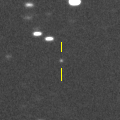
|
Now it is 17.8 mag (Dec. 28, Toshihiko Ikemura, Hirohisa Sato). It will brighten up to 16 mag in March, and it will be observable in good condition.
Date(TT) R.A. (2000) Decl. Delta r Elong. m1 Best Time(A, h)
Jan. 25 11 59.99 44 12.1 1.074 1.860 129 17.3 3:46 (180, 81)
Feb. 1 11 55.63 44 8.8 1.007 1.832 133 17.1 3:15 (180, 81)
|
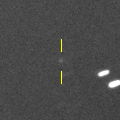
|
Now it is 17.7 mag (Jan. 19, Toshihiko Ikemura, Hirohisa Sato). It will brighten very rapidly after this. It will brighten up to 8-9 mag from summer to autumn. It will be observable in excellent condition in the Southern Hemisphere. It locates very low around the high light in the Northern Hemisphere.
Date(TT) R.A. (2000) Decl. Delta r Elong. m1 Best Time(A, h)
Jan. 25 13 29.22 -4 48.4 2.288 2.668 101 17.5 5:15 ( 0, 50)
Feb. 1 13 33.92 -5 8.9 2.152 2.624 107 17.2 4:52 ( 0, 50)
|

|
Now it is 17.5 mag (Jan. 5, Toshihiko Ikemura, Hirohisa Sato). It will brighten up to 16.5 mag and will be observable in good condition in March.
Date(TT) R.A. (2000) Decl. Delta r Elong. m1 Best Time(A, h)
Jan. 25 13 12.45 -0 42.8 1.623 2.131 107 17.3 4:58 ( 0, 54)
Feb. 1 13 19.19 -1 4.9 1.550 2.131 112 17.2 4:38 ( 0, 54)
|
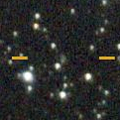
|
Now it is 16.6 mag (Dec. 27, Toshihiko Ikemura, Hirohisa Sato). It will brighten up to 12 mag in winter in 2022. In the Northern Hemisphere, it stays observable in good condition for a long time, although it becomes low from February to March. In the Southern Hemisphere, it is not observable until 2021 November.
Date(TT) R.A. (2000) Decl. Delta r Elong. m1 Best Time(A, h)
Jan. 25 22 32.53 40 23.6 7.324 6.990 66 17.3 18:48 (118, 37)
Feb. 1 22 37.76 40 27.3 7.343 6.945 62 17.2 18:54 (120, 32)
|

|
Now it is 18.4 mag (Jan. 3, A. Sonka). It will brighten up to 17 mag from February to March. It is not observable in the Southern Hemisphere.
Date(TT) R.A. (2000) Decl. Delta r Elong. m1 Best Time(A, h)
Jan. 25 0 14.46 6 7.7 1.636 1.455 61 17.4 18:48 ( 64, 42)
Feb. 1 0 30.58 9 37.1 1.670 1.449 59 17.3 18:54 ( 71, 41)
|
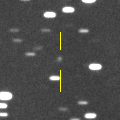
|
Now it is 17.4 mag (Dec. 28, Toshihiko Ikemura, Hirohisa Sato). It stays observable at 16.5 mag for a long time from 2020 to 2021. In the Northern Hemisphere, it is observable in excellent condition for a long time. In the Southern Hemisphere, it is not observable until 2021 summer.
Date(TT) R.A. (2000) Decl. Delta r Elong. m1 Best Time(A, h)
Jan. 25 0 56.13 75 19.8 6.285 6.578 103 17.6 18:48 (169, 47)
Feb. 1 0 55.11 74 3.0 6.331 6.558 98 17.5 18:54 (165, 46)
|
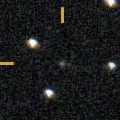
|
Now it is 17.3 mag (Dec. 27, Kunihiro Shima). It is observable at 17-18 mag for a long time from late 2019 to early 2021. It will fade out before it passes the perihelion.
Date(TT) R.A. (2000) Decl. Delta r Elong. m1 Best Time(A, h)
Jan. 25 2 52.39 3 2.9 4.820 5.039 97 17.6 18:48 ( 5, 58)
Feb. 1 2 53.76 3 35.1 4.915 5.026 90 17.6 18:54 ( 20, 57)
|
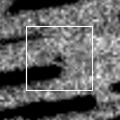
|
It is observable at 17.5 mag in good condition until spring.
Date(TT) R.A. (2000) Decl. Delta r Elong. m1 Best Time(A, h)
Jan. 25 16 32.53 -16 52.8 2.556 2.154 55 17.6 5:36 (316, 25)
Feb. 1 16 46.06 -17 14.6 2.511 2.177 59 17.7 5:32 (319, 26)
|

|
Now it is 17.2 mag (Nov. 25, ATLAS-MLO). It brightened up to 14 mag from autumn to winter in 2018. Now it is fading. It is observable at 17.5 mag in good condition from winter to spring.
Date(TT) R.A. (2000) Decl. Delta r Elong. m1 Best Time(A, h)
Jan. 25 13 49.07 -2 33.8 4.052 4.299 97 17.8 5:35 ( 0, 52)
Feb. 1 13 48.84 -2 49.3 3.981 4.339 104 17.7 5:07 ( 0, 52)
|

|
It will brighten up to 13 mag in 2022. In 2020, it is observable at 17.5 mag in good condition in spring. It locates somewhat low in the Southern Hemisphere.
Date(TT) R.A. (2000) Decl. Delta r Elong. m1 Best Time(A, h)
Jan. 25 10 50.53 18 56.4 3.751 4.600 145 17.8 2:37 ( 0, 74)
Feb. 1 10 47.49 19 24.6 3.687 4.588 153 17.7 2:07 ( 0, 74)
|

|
Now it is 17.7 mag (Dec. 31, Toshihiko Ikemura, Hirohisa Sato). It will be fainter than 18 mag in late April.
Date(TT) R.A. (2000) Decl. Delta r Elong. m1 Best Time(A, h)
Jan. 25 12 45.36 7 41.6 10.212 10.683 116 17.8 4:31 ( 0, 63)
Feb. 1 12 45.37 7 57.2 10.129 10.700 123 17.8 4:04 ( 0, 63)
|

|
Now it is 17.5 mag (Jan. 18, Katsumi Yoshimoto). Hidetaka Sato reported its cometary activity was detected on Dec. 6. It will approach to Sun down to 0.9 a.u. in June, and it is extected to brighten up to 12 mag. In the Southern Hemisphere, it stays observable in good condition for a long time after this. In the Northern Hemisphere, it will be unobservable from late March to late June.
Date(TT) R.A. (2000) Decl. Delta r Elong. m1 Best Time(A, h)
Jan. 25 4 9.51 -27 40.9 2.049 2.454 102 18.0 19:52 ( 0, 27)
Feb. 1 4 3.50 -27 35.5 2.047 2.368 96 17.8 19:19 ( 0, 27)
|
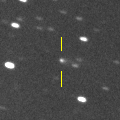
|
Now it is 16.5 mag (Dec. 28, Toshihiko Ikemura, Hirohisa Sato). It is observable at 17 mag in good condition in winter. It locates somewhat low in the Southern Hemisphere.
Date(TT) R.A. (2000) Decl. Delta r Elong. m1 Best Time(A, h)
Jan. 25 3 55.94 22 24.0 2.633 3.207 117 17.9 19:40 ( 0, 77)
Feb. 1 3 58.12 22 21.9 2.721 3.205 110 18.0 19:15 ( 0, 77)
|
|
![]()
 C/2019 L3 ( ATLAS )
C/2019 L3 ( ATLAS ) 112P/Urata-Niijima
112P/Urata-Niijima C/2019 T3 ( ATLAS )
C/2019 T3 ( ATLAS ) 173P/Mueller 5
173P/Mueller 5 175P/Hergenrother
175P/Hergenrother (944) Hidalgo
(944) Hidalgo 117P/Helin-Roman-Alu 1
117P/Helin-Roman-Alu 1 C/2014 B1 ( Schwartz )
C/2014 B1 ( Schwartz ) A/2019 U6
A/2019 U6 203P/Korlevic
203P/Korlevic![]()







































